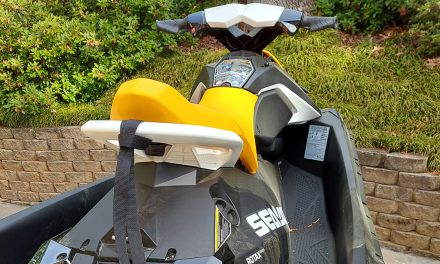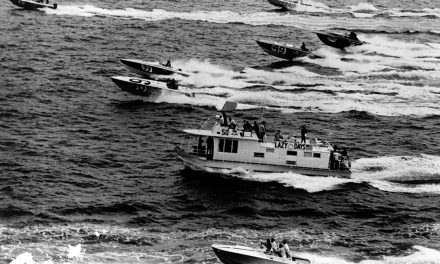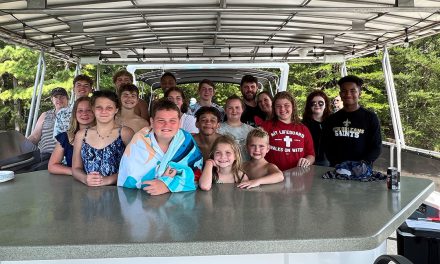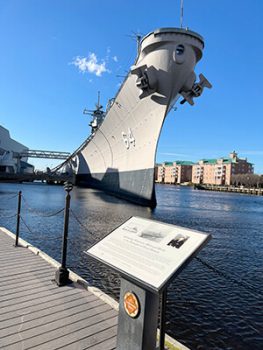
Looming large among the docks, the USS Wisconsin cuts an impressive figure.
Not many people think about going to a beach destination in February, but when I was invited to a conference with other travel journalists from across the U.S. last winter, I jumped at the chance. My visit to Norfolk and Virginia Beach yielded plenty to do without even getting my feet wet.
Three days in Norfolk introduced me to the hub of the U.S. Navy, Naval Station Norfolk, which supports 75 ships and 134 aircraft with 14 piers and 11 aircraft hangars. While I didn’t visit the base, I had plenty of chances to get up close to ships, aircraft and the ocean.
The Navy presence was more than obvious less than two blocks behind our hotel. The USS Wisconsin, www.NorfolkVisitor.com, built for WWII and seeing action in the Korean War and Operation Desert Storm, is docked adjacent to Nauticus Museum. Its sheer mass is overwhelming as it towers over the pier. It’s open for self-guided tours but many veterans volunteer to provide back-stories of their own service and the life of the ship. They had engaging stories and yet willingly listened to the daughter of a torpedo-bomber WWII Navy pilot about her father’s adventures in the Pacific.
At just over 887 feet long with a beam of more than 108 feet, it carried more than 1,900 officers and men into battle. Imagine that many people on a ship working in shifts, sleeping in bunks and navigating narrow passageways and steep ladder-like stairs in rough seas.
Close by, the Schooner Virginia is dwarfed by the USS Wisconsin. It’s a reproduction of the last tall sail ship built for the Virginia Pilot Association and offers hands-on learning experiences.
Nauticus Museum Marine Discovery Center next door, www.nauticus.org, allows visitors to explore the area’s maritime history and all things nautical, including weather, sea life and marine technology.
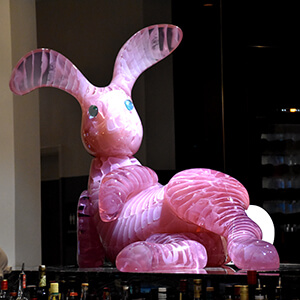
A giant reclining 7-foot rabbit oversees the bar at Norfolk’s Glass Light Hotel
Norfolk is about more than its naval culture. It is known for its appreciation of all things glass. The Chrysler Museum of Art, www.chrysler.org. As a collector, I could have stayed there for several days to ogle at the 30,000 objects, some that date back more than 5,000 years from Egyptian tombs to glass mosaics, Tiffany windows and art glass.
The Glass Light Hotel and Gallery, our home for three days, is a museum in itself. A massive pink glass bunny, at least eight feet tall, welcomes guests at check-in and more than 60 pieces of art glass are showcased throughout the lobby bar and reception area. Another pink bunny reclines behind the bar. The two-level gallery, accessible from the hotel lobby, features works by Dale Chihuly and renowned glass artists.
And I can’t forget to mention Norfolk’s answer to the Gainesville Chicken statues: colorful mermaids that surprise visitors on street corners, in front of historic buildings and in parks. Each has its own story on a plaque and all are charming.
Virginia Beach
Our next four days in Virginia Beach revealed the many attractions available even in the off-season. When we arrived, another journalist and I headed to the Military Aviation Museum, www.MilitaryAviationMuseum.org, about 30 minutes south of Hampton Roads for a tour by operations director Mitchell Welch.
The museum showcases one of the largest private collections of WWI and WWII military aircraft in the world, with restored and operable U.S., British, German versions from around the world. Located on an airfield that’s still used, there’s an Army hangar, a Navy hangar, a WWI hangar and a Fighter Factory restoration and maintenance facility.
The 15,000-square foot Army hangar is filled wing-to-wing with U.S. Army Air Corp aircraft, and planes from Great Britain, Russia and other countries. You can see the P-51 Mustang, the Curtiss P-40, the B-25 Mitchell, the Spitfire, Hurricane and three Polikarpovs eyeball-to-eyeball.
The Navy hangar’s planes include a PBY Catalina, Corsair, Skyraider and TBM Avenger along with the unique DeHavilland Dragon Rapide and the N3N Canary.
Visit the WWI hangar for an extensive collection of biplanes and triplanes, wood and fabric craft and an assortment of various models of the German Fokker.
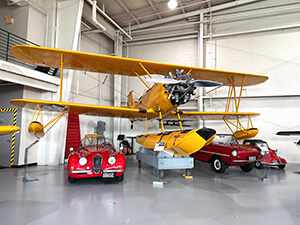
Classic red collector’s automobiles, including an Alfa Romeo, are parked beneath the wings of a vintage seaplane.
An authentic German Luftwaffe hangar was relocated from the Cottbus Army Airfield to the museum. Built in 1934, it was designed for portability and speed of disassembly and reassembly. It was originally located next to a pilot flight school. From 1941-44 it was used for storage and as a base for test flights.
Almost all the aircraft in the museum have been restored to flying condition. They often go to airshows around the country.
This is another place where I could have stayed all day.
Other attractions during our four days included a visit to the Edgar Cayce Association for Research and Enlightenment, www.EdgarCayce.org, where the man known as the “sleeping prophet” studied dreams and holistic medicine.
We visited the historic Cavalier Hotel, www.CavalierResortvb.com, for a group brunch and learned about the burgeoning farm-raised oyster business in the Lynnhaven River, www.PleasureHouseOysters.com. The area offers oyster tours that put guests into the action, actually harvesting oysters from the river that are raised off-bottom, then sampling them straight from the water.
The area is prime for dolphin and whale watching, so the last day of our stay, we booked a whale-watching cruise. The weather was blustery and perhaps the coldest temperatures of our February trip, but nearly a dozen travel journalists, layered from head to toe in hats, gloves, sweaters, jackets, long underwear, extra socks, scarves and more gloves, braved the cold.
We journeyed into the Atlantic with Rudee Tours, www.RudeeTours.com, and bravely stood huddled in the bow of the boat waiting for a whale to breach the surface of the choppy water. With cameras in hand, we waited, looking for tell-tale spitting blowholes and the broad backs of the whales.
An onboard guide explained the life of the sperm whale, which lives on plankton. We came inside to warm up, then faithfully dashed outside at the mere mention of a sighting.
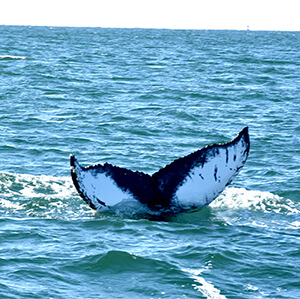
More than a fluke: Whale-watching requires patience, sometimes you are lucky enough to see a beautiful fluke.
Finally, after almost two hours of cruising around the water within sight of land, a whale made our day. He did a backflip and was greeted by screams and applause. Of course, wouldn’t you know it? I was inside trying to get warm and un-freeze my fingers from being so cold that I couldn’t even push the shutter release.
I hurried outside just in time to see his second breach, catching a glimpse and a photo of his beautiful fluke as it disappeared back into the sea.
The good news? All of us travel journalists found out that no matter when you visit Norfolk and Virginia Beach, there is plenty to do and see. I certainly plan a return trip – perhaps when it’s a little less chilly – to continue my explorations.
Photos: by Pamela A. Keene

